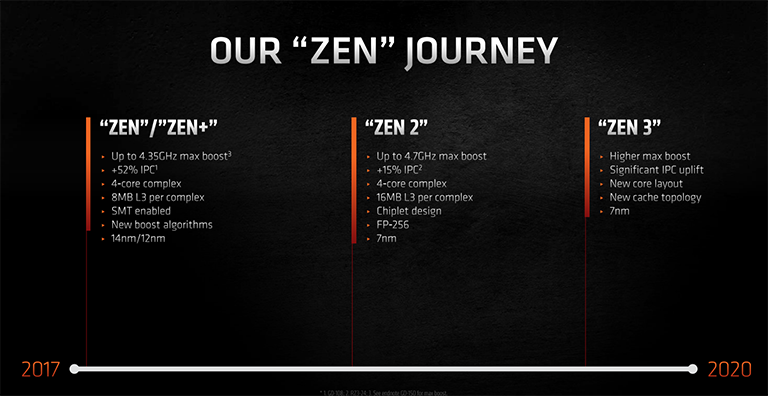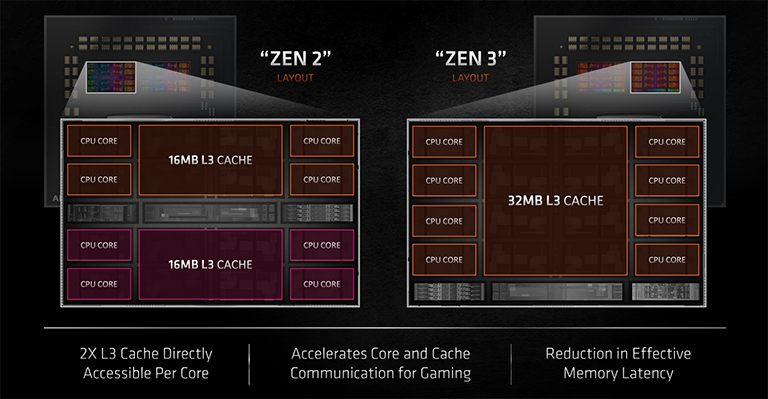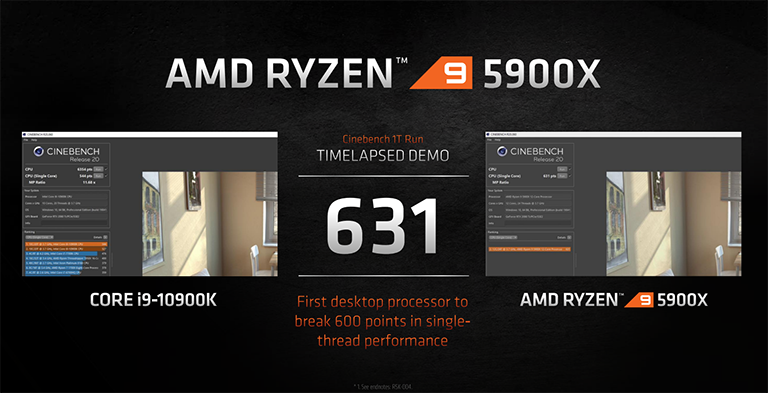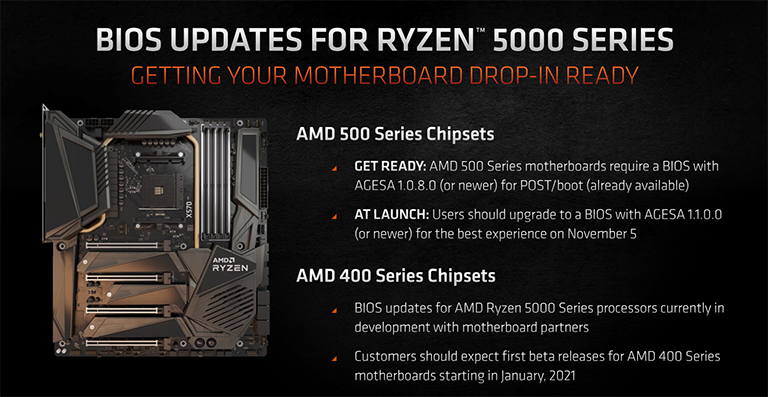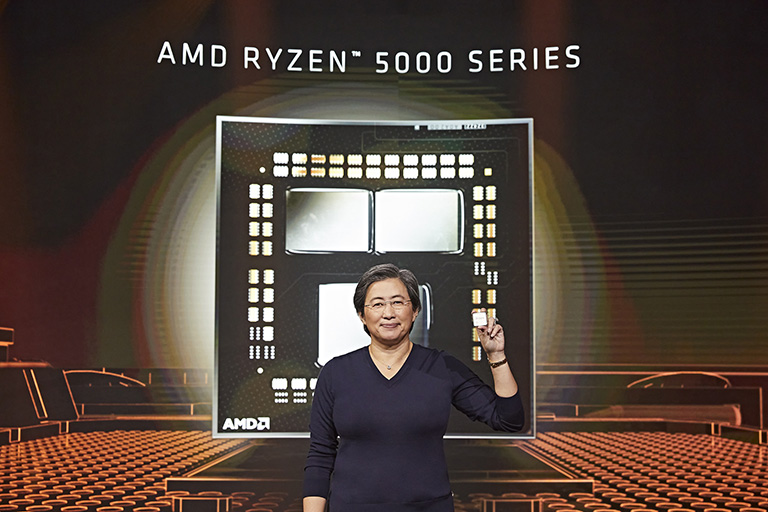
Most of AMD's recent resurgence can be directly attributed to the success of the Zen CPU microarchitecture that's now successfully ensconced in mobile, desktop and server processors.
Clean-sheet Zen arrived in March 2017, a second-generation design grabbed all the low-hanging architecture fruit in April 2018, while third-gen heralded deeper architecture refinements and a doubling of mainstream cores in July 2019.
Serendipitous to AMD's laser focus and on-time execution, rival Intel's run into manufacturing delays and consequent roadmap slips for its Core line.
Despite what's happening around the world, the AMD execution clock calls time on the next improvement for Zen. This fourth-generation arrival uses a further refined Zen 3 architecture and is first debuted on desktop Ryzen processors tagged with 5000-series branding.
Zen 3 vs. Zen 2 improvements
It is instructive to consider the improvements AMD's engineers have made in the move from the capable Zen 2 core to Zen 3. Such grounding provides context for understanding benchmark performance.
This AMD slide neatly summarising the key improvements for Zen 3. Mixing architecture and models for a brief moment, it is important to temper overall expectations by appreciating that Zen 3 retains the same core-and-thread topology as incumbent Zen 2. You are not going to see a doubling of compute resources and improved architecture in one fell swoop. Zen 2 set the overall bar high; Zen 3 gives it a healthy, but not incredible, bump upwards.
With that out of the way, the aim of Zen 3, according to AMD, is to lift both instructions per clock (IPC) and frequency over Zen 2... without changing manufacturing process or increasing socket power for the long-standing AM4 socket.
Through changes we'll detail below, AMD says it has achieved a 19 percent IPC uplift over Zen 2 based on a geomean of 25 common workloads. IPC is agnostic of frequency, meaning the gains emanate from 'hard-nosed' architecture improvements alone.
Putting this into context, you may recall that Zen 2 achieved a 13 percent IPC uplift over Zen+ and 16 percent over original Zen. AMD promises more in a shorter timeframe.
We'll go into the nuts and bolts of architecture improvements as they're disclosed closer to the launch, but the takeaway from this slide is Zen 3 is closer to a clean-sheet revamp than tinkering in area. Clever processor design is a balancing act of adequately feeding each segment - front-end, execution, retire - without introducing additional bottlenecks. It's clear here that a large part of Zen 3's IPC gains arrive from improving the front-end and adding another load-store unit.
A large chunk of those gains is more readily understood when you view the change in processor topology. The above slide takes in a very high-level overview of Zen 2 (left) and Zen 3 (right). Outside of refinements to core logic, the way in which these execution engines interface with various strata of memory has been a source for picking off that low-hanging fruit.
Looking at an eight-core block, Zen 2 uses two four-core CCXes that each have access to their internal L1/L2 cache and external pool of L3 memory. These CCXes are tied together to form an eight-core CCD. It's clear this is a less-than-optimal strategy, so Zen 3 gets rid of CCXes and replaces them with a monolithic CCD where each core has access to a full 32MB of L3 cache. Overall cache doesn't change, of course, but the way in which cores access them does.
The upshot from this approach is simple to predict. There's less potential core-to-core latency and less potential core-to-cache latency. Makes sense as the CPU cores don't need to jump through extra layers of fabric for communication.
In particular, says AMD, this cleaner caching arrangement and gateway to a double-sized L3 pool is a definite boon to applications such as gaming, where a couple of threads dominate accesses and have hither-to been limited by relatively high caching speeds.
As before, the 7nm cores use Infinity Fabric to connect to a separate 12nm IOD block which contains the memory controller and a general I/O hub. This is why you will see three distinct chiplets on 12- and 16-core chips - two CCDs and a single IOD. Eight-core models ought to carry two.
There's no mention of any baked-in support for accelerating AI tasks, unlike Intel, and it's clear AMD concerns are more on improving single-thread performance and gaming this generation.
Zen 3 models - enter Ryzen 5000-series
Contrary to rumours, AMD taps up foundry partner TSMC for the same 7nm process as used on Zen 2. The exact recipe is likely tweaked to offer a more amenable voltage/frequency curve where the processors stay resident at higher speeds for more of the time. You can also read that statement as AMD offering higher frequencies without requiring extra power, so let's see how the quartet of announced Ryzen 5000-series processors line up against their incumbents.
Desktop AMD Ryzen product range | ||||||||||
|---|---|---|---|---|---|---|---|---|---|---|
| Model |
Cores / Threads
|
TDP
|
L3 Cache
|
Base Clock
|
Turbo Clock
|
Process
|
PCIe
|
DDR4
|
Package
|
Price
|
AMD Ryzen 9 | ||||||||||
| Ryzen 9 5950X |
16 / 32
|
105W
|
64MB
|
3.4GHz
|
4.9GHz
|
7nm
|
24
|
Dual 3200
|
AM4
|
$799
|
| Ryzen 9 3950X |
16 / 32
|
105W
|
64MB
|
3.5GHz
|
4.7GHz
|
7nm
|
24
|
Dual 3200
|
AM4
|
$749
|
| Ryzen 9 5900X |
12 / 24
|
105W
|
64MB
|
3.7GHz
|
4.8GHz
|
7nm
|
24
|
Dual 3200
|
AM4
|
$549
|
Ryzen 9 3900XT |
12 / 24
|
105W
|
64MB
|
3.8GHz
|
4.7GHz
|
7nm
|
24
|
Dual 3200
|
AM4
|
$499
|
| Ryzen 9 3900X |
12 / 24
|
105W
|
64MB
|
3.8GHz
|
4.6GHz
|
7nm
|
24
|
Dual 3200
|
AM4
|
$499
|
AMD Ryzen 7 | ||||||||||
| Ryzen 7 5800X |
8 / 16
|
105W
|
32MB
|
3.8GHz
|
4.7GHz
|
7nm
|
24
|
Dual 3200
|
AM4
|
$449
|
Ryzen 7 3800XT |
8 / 16
|
105W
|
32MB
|
3.9GHz
|
4.7GHz
|
7nm
|
24
|
Dual 3200
|
AM4
|
$399
|
| Ryzen 7 3800X |
8 / 16
|
105W
|
32MB
|
3.9GHz
|
4.5GHz
|
7nm
|
24
|
Dual 3200
|
AM4
|
$399
|
| Ryzen 7 3700X |
8 / 16
|
65W
|
32MB
|
3.6GHz
|
4.4GHz
|
7nm
|
24
|
Dual 3200
|
AM4
|
$329
|
| Ryzen 7 2700X |
8 / 16
|
105W
|
16MB
|
3.7GHz
|
4.3GHz
|
12nm
|
24
|
Dual 2933
|
AM4
|
$329
|
| Ryzen 7 2700 |
8 / 16
|
65W
|
16MB
|
3.2GHz
|
4.1GHz
|
12nm
|
24
|
Dual 2933
|
AM4
|
$299
|
| Ryzen 7 1800X |
8 / 16
|
95W
|
16MB
|
3.6GHz
|
4.0GHz
|
14nm
|
24
|
Dual 2666
|
AM4
|
$349
|
| Ryzen 7 1700X |
8 / 16
|
95W
|
16MB
|
3.4GHz
|
3.8GHz
|
14nm
|
24
|
Dual 2666
|
AM4
|
$309
|
| Ryzen 7 1700 |
8 / 16
|
65W
|
16MB
|
3.0GHz
|
3.7GHz
|
14nm
|
24
|
Dual 2666
|
AM4
|
$299
|
AMD Ryzen 5 | ||||||||||
| Ryzen 5 5600X |
6 / 12
|
65W
|
32MB
|
3.7GHz
|
4.6GHz
|
7nm
|
24
|
Dual 3200
|
AM4
|
$299
|
Ryzen 5 3600XT |
6 / 12
|
95W
|
32MB
|
3.8GHz
|
4.5GHz
|
7nm
|
24
|
Dual 3200
|
AM4
|
$249
|
| Ryzen 5 3600X |
6 / 12
|
95W
|
32MB
|
3.8GHz
|
4.4GHz
|
7nm
|
24
|
Dual 3200
|
AM4
|
$249
|
| Ryzen 5 3600 |
6 / 12
|
65W
|
32MB
|
3.6GHz
|
4.2GHz
|
7nm
|
24
|
Dual 3200
|
AM4
|
$199
|
| Ryzen 5 2600X |
6 / 12
|
95W
|
16MB
|
3.6GHz
|
4.2GHz
|
12nm
|
24
|
Dual 2933
|
AM4
|
$229
|
| Ryzen 5 2600 |
6 / 12
|
65W
|
16MB
|
3.4GHz
|
3.9GHz
|
12nm
|
24
|
Dual 2933
|
AM4
|
$199
|
| Ryzen 5 1600X |
6 / 12
|
95W
|
16MB
|
3.6GHz
|
4.0GHz
|
14nm
|
24
|
Dual 2666
|
AM4
|
$219
|
| Ryzen 5 1600 |
6 / 12
|
65W
|
16MB
|
3.2GHz
|
3.6GHz
|
14nm
|
24
|
Dual 2666
|
AM4
|
$189
|
| Ryzen 5 3400G |
4 / 8
|
65W
|
4MB
|
3.7GHz
|
4.2GHz
|
12nm
|
24
|
Dual 2933
|
AM4
|
$149
|
| Ryzen 5 2400G |
4 / 8
|
65W
|
4MB
|
3.6GHz
|
3.9GHz
|
14nm
|
16
|
Dual 2933
|
AM4
|
$169
|
| Ryzen 5 1500X |
4 / 8
|
65W
|
16MB
|
3.5GHz
|
3.7GHz
|
14nm
|
24
|
Dual 2666
|
AM4
|
$174
|
| Ryzen 5 1400 |
4 / 8
|
65W
|
8MB
|
3.2GHz
|
3.4GHz
|
14nm
|
24
|
Dual 2666
|
AM4
|
$169
|
AMD Ryzen 3 | ||||||||||
| Ryzen 3 3300X |
4 / 8
|
65W
|
16MB
|
3.8GHz
|
4.3GHz
|
7nm
|
24
|
Dual 3200
|
AM4
|
$120
|
Ryzen 3 3100 |
4 / 8
|
65W
|
16MB
|
3.6GHz
|
3.9GHz
|
7nm
|
24
|
Dual 3200
|
AM4
|
$99
|
Ryzen 3 3200G |
4 / 4
|
65W
|
4MB
|
3.6GHz
|
4.0GHz
|
14nm
|
16
|
Dual 2933
|
AM4
|
$99
|
| Ryzen 3 2200G |
4 / 4
|
65W
|
4MB
|
3.5GHz
|
3.7GHz
|
14nm
|
16
|
Dual 2933
|
AM4
|
$99
|
| Ryzen 3 1300X |
4 / 4
|
65W
|
8MB
|
3.5GHz
|
3.7GHz
|
14nm
|
24
|
Dual 2666
|
AM4
|
$129
|
| Ryzen 3 1200 |
4 / 4
|
65W
|
8MB
|
3.1GHz
|
3.4GHz
|
14nm
|
24
|
Dual 2666
|
AM4
|
$109
|
The new processors are emboldened across the specs. Though obvious, AMD skips the 4000-series desktop branding due to any potential conflicts with mobile parts bearing the same name. Ryzen 5000-series is based solely on Zen 3 goodness.
One first aspect that ought to jump out is AMD's launching the 16C32T champion chip at the same time as the 12/8/6-core models. That's in contrast to the staggered approach last time around, where the beefiest processor came later.
There's not too much to say here other than peak frequencies are a little higher than the equivalent Ryzen 3000-series parts. What is not known is how the new chips' frequencies will relate in real-world use in single- and multi-threaded applications. We'll find out in due course during our own testing. It's also telling that, for now, AMD has dropped the T suffix, indicating there ought to be still-faster 5000-series processors down the line.
Compared to similar chips in the arsenal, AMD tacks on an extra $50 for each 5000-series processor, arguing the gains in IPC and, potentially, frequency maintain Ryzen's bang-for-buck perspective. That's true, yet as is the case whenever one family is introduced, the incumbents price generally drops. As a point of reference, the Ryzen 9 3900XT can be purchased for as little as $430, putting value pressure on faster Ryzen 9 5900X out of the gate.
That premium also hurts for the Ryzen 5 5600X, as $50 represents a 20 percent jump on SRP, or more when any discounting is taken into account. Builders using these kinds of chips are naturally more sensitive to higher costs, but may be assauged by its restrained 65W TDP. It's also the only 5000-series chip to ship with a cooler in the box, though the bundled Wraith Stealth is a step down from the Wraith Spire v2 present in the Ryzen 5 3600XT box.
Performance Musings - Beating up on Intel?
Understanding the real-world performance impact of frequency and IPC is not readily discernible from specs alone. AMD provides some guidance by running internal benchmarks against its own chips and, most notably, a battery of Intel Core models.
AMD is not shy in heralding the Ryzen 9 5900X's credentials. Its own benchmarks indicate single-thread hegemony in AMD's favourite benchmark, Cinebench R20, by claiming a massive 631 marks in the 1T test. We have not seen anything faster than 540 marks from a desktop chip to date.
Ryzen 9 5900X is also claimed to be, for now, the 'world's fastest gaming processor' relegated the Core i9-10900K to erstwhile champ status when evaluated over 10 games at the CPU-sensitive FHD resolution. Bold claims indeed, as our recent examination with a GeForce RTX 3090 highlighted FHD gains for Intel. Said Ryzen 9 5900X also lays the gaming smackdown on the Ryzen 9 3900XT, which features the same core-and-thread count.
In other comparisons, AMD reports healthy gains for the 5950X against the current best-in-class 3950X across video editing, rendering, CAD, compiling and gaming. Take these with the appropriate pinch of salt because AMD will inevitably highlight best-case scenarios. The company further believes Zen 3 gives enough extra gas to enable the 16-core Ryzen 9 5950X to at least match the Intel Core i9-10900K in gaming whilst beating it in rendering through its core muscle advantage.
Practicalities
Based on the existing AM4 form factor, Ryzen 5000-series will work on 500-series chipsets (X570, B550) through a BIOS update incorporating AGESA 1.0.8.0. AMD says it has been working with all the major motherboard partners to ensure all prominent models have the appropriate BIOS support in time for launch.
Those with older 400-series chipset-based motherboards have to wait longer, until at least January next year. AMD is clearly pushing users to the latest 500-series chipsets. Makes sense, too, as they expose PCIe 4.0 support in its fullest form.
Wrap
All four Ryzen 5000-series chips will be on-shelf on November 5. From what we can gather from the initial public release, AMD has focussed Zen 3's ambitions to what was considered a minor weak point: gaming. The cleaner architecture paves the way to lower-latency access which is a natural fit for high-framerate frolics.
Zen 3 is an important launch as it defines AMD's architecture thought process for this year and next. If the numbers stack up in our own testing, it becomes increasingly difficult to make a case for the rival Intel Core products. Rocket Lake cannot come soon enough.
Claiming best-in-class performance in every area is setting the bar awfully high. Wait until November 5 for us to tell you whether AMD does indeed make the promised leap forward.
In the meantime, AMD will provide juicier details during its Gaming Event on October 28.



